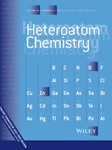Remarkable Differences in Amine Substitution Reactions of Trichloromethyl and Trifluoromethyl Difluorophosphines, CX3PF2 (X = F, Cl): A Computational Study
Dedicated to Prof. Manfred Scheer on the occasion of his 60th birthday.
Contract grant sponsor: Hungarian Scientific Research Fund (OTKA). Contract grant number: K 105417. Contract grant sponsor: European Cooperation in Science and Technology (COST). Contract grant number: CM1302.
ABSTRACT
Detailed computational studies have been carried out to explain the unexpected differing reactions that occur between dimethylamine and the difluorophosphines, CX3PF2 (X = F, Cl). The reaction affords the thermodynamically controlled product chloroform in the case of X = Cl, whereas when X = F the analogous reaction pathway leading to fluoroform is hindered by a substantial reaction barrier in the gas phase, where the reaction should take place due to the volatility of the reactant. While the gas-phase reaction energy gap is somewhat reduced when X = Cl, due to the stability of the migrating CCl3− moiety, the still substantial barrier does not account for the chloroform formation. Polarizable continuum model (PCM) calculations indicate a reduction of the barrier, facilitating the liquid-phase reaction. The alternative gas-phase reaction path, resulting in the aminolysis of a P—F bond is reversible and is shifted toward the product by capturing HF as the dimethylamino salt of the [CF3PF4H]− anion.




